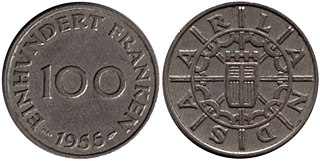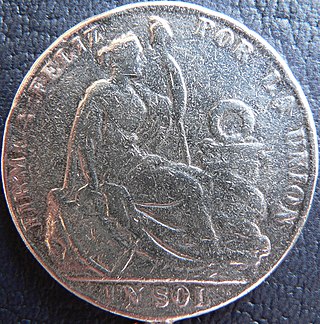
The franc is any of various units of currency. One franc is typically divided into 100 centimes. The name is said to derive from the Latin inscription francorum rex used on early French coins and until the 18th century, or from the French franc, meaning "frank".

The peseta was the currency of Spain between 1868 and 2002. Along with the French franc, it was also a de facto currency used in Andorra.

The sol, later sol de oro, was the currency of Peru between 1863 and 1985. It had the ISO 4217 currency code PES. It was subdivided into 10 dineros or 100 centavos. It also had two different superunits over its circulation life, the inca (1881-1882) and later the gold pound, both worth 10 soles.
The kwanza is the currency of Angola. Four different currencies using the name kwanza have circulated since 1977.

The lira was the currency of Italy between 1861 and 2002. It was introduced by the Napoleonic Kingdom of Italy in 1807 at par with the French franc, and was subsequently adopted by the different states that would eventually form the Kingdom of Italy in 1861. It was subdivided into 100 centesimi, which means "hundredths" or "cents". The lira was also the currency of the Albanian Kingdom from 1941 to 1943.

The ariary is the currency of Madagascar. It is notionally subdivided into 5 iraimbilanja and is one of only two non-decimal currencies currently circulating. The names ariary and iraimbilanja derive from the pre-colonial currency, with ariary being the name for a silver dollar. Iraimbilanja means literally "one iron weight" and was the name of an old coin worth 1⁄5 of an ariary. However, as of May 2023, the unit is effectively obsolete since the iraimbilanja has practically no purchasing power, and the coins have fallen into disuse.
The Loti is the currency of the Kingdom of Lesotho. It is subdivided into 100 lisente. It is pegged to the South African rand on a 1:1 basis through the Common Monetary Area, and both are accepted as legal tender within Lesotho. The loti was first issued in 1966, albeit as a non-circulating currency. In 1980, Lesotho issued its first coins denominated in both loti and lisente to replace the South African rand, but the rand remains legal tender.

The dinar is the national currency of Tunisia. It is subdivided into 1000 milim or millimes (ملّيم). The abbreviation DT is often used in Tunisia, although writing "dinar" after the amount is also acceptable ; the abbreviation TD is also mentioned in a few places, but is less frequently used, given the common use of the French language in Tunisia, and the French derivation of DT.

The franc was the currency of Madagascar until 1 January 2005. It was subdivided into 100 centimes. In Malagasy the corresponding term for the franc is iraimbilanja, and five Malagasy francs is called ariary.

The Belgian franc was the currency of the Kingdom of Belgium from 1832 until 2002 when the Euro was introduced. It was subdivided into 100 subunits, each known as a centiem in Dutch, centime in French or a Centime in German.

The Rwandan franc is the currency of Rwanda. It is subdivided into 100 centimes.

The Guinean franc is the currency of Guinea. It is subdivided into one hundred centimes, but no centime denominations were ever issued.
The franc is the official currency of Comoros. It is nominally subdivided into 100 centimes, although no centime denominations have ever been issued.
The franc was the currency of the Anglo-French Condominium of the Pacific island group of the New Hebrides. It circulated alongside British and later Australian currency. The New Hebrides franc was nominally divided into 100 Centimes, although the smallest denomination was the 1 franc. Between 1945 and 1969, it was part of the CFP franc.

The Katangese franc, was the currency of the unrecognized State of Katanga between 1960 and 1963 during its brief period of independence from the Republic of the Congo. It replaced the Congolese franc at par and was consequently initially equal to the Belgian franc. This established an exchange rate of 50 francs = 1 U.S. dollar. Just before Katanga was re-annexed by Congo, the exchange rate had fallen to 195 francs = 1 U.S. dollar. The currency was replaced at par by the Congolese franc.
The ekwele or ekuele was the currency of Equatorial Guinea between 1975 and 1985. Although nominally divided into 100 céntimos, no subdivisions were issued. The name ekuele was used until 1979, whilst ekwele was used after. The renaming of the currency to "ekwele" from "peseta" was motivated largely by a sweeping Africanization program meant to rid the country of its colonial past by removing Spanish names and references from the public domain; the ekpele was a pre-colonial iron currency used by the Fang and Beti people.
The peso was the currency of Guinea-Bissau from 1975 to 1997 and was divided into 100 centavos. It replaced the escudo at par. In 1997, in an effort to stop high inflation, Guinea-Bissau adopted the CFA franc, using a conversion rate of 65 pesos to the franc.
The Malian franc was the independent currency of Mali between 1962 and 1984. Although technically subdivided into 100 centimes, no subdivisions were issued.

The Central African CFA franc is the currency of six independent states in Central Africa: Cameroon, Central African Republic, Chad, Republic of the Congo, Equatorial Guinea and Gabon. These six countries have a combined population of 55.2 million people, and a combined GDP of over US$100 billion.

The West African CFA franc is the currency used by eight independent states in West Africa which make up the West African Economic and Monetary Union : Benin, Burkina Faso, Côte d'Ivoire, Guinea-Bissau, Mali, Niger, Senegal and Togo. These eight countries had a combined population of 105.7 million people in 2014, and a combined GDP of US$128.6 billion.













